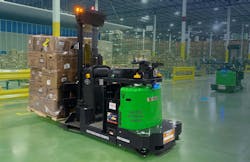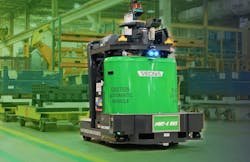Traditionally, material handling automation has been associated with rigid installments and operations, such as automated storage and retrieval systems (ASRS) which require significant investments and efforts to implement. In this scenario, entire systems can become obsolete when a facility's workflows or layouts change to accommodate shifting demands. However, the use of more modern flexible technologies—robots in particular—in an automated warehouse can establish a more adaptable approach to manufacturing that boosts efficiency gains.
As warehouse robots move from innovative, one-off demonstrations to commonplace fixtures, understanding what flexible warehouse automation is and the technology that makes it possible is the key to a successful, future-proofed investment.
What is warehouse automation?
Warehouse automation refers to the complex system of hardware, software and other technologies used to automate manual warehouse tasks and processes to increase productivity and cut costs.
Certain types of warehouse automation, such as AGVs (automated guided vehicles) were designed to follow pre-planned paths for transporting warehouse goods and materials but struggle to independently adjust for obstacles or errors. Autonomous mobile robots (AMRs), however, embrace versatility and respond to evolving needs with limited human intervention due to their ability to navigate a facility without having to follow a specified path. This adaptability is achieved through the integration of technologies like advanced processing, machine learning and connectivity platforms.
The key benefits of using modern warehouse automation include:
- Enhanced efficiency: With mounting pressure to fulfill mass-customization demands and deliver dependable takt times (i.e., the time required to assemble a product to match the demand for it), manufacturing warehouses can boost efficiency with flexible warehouse automation. Technologies such as AMRs enable faster setup times, reduced downtime and efficient adaptation to new tasks as new needs arise. This translates to higher overall productivity and better resource utilization.
- Scalability and cost-effectiveness: Businesses can easily scale their operations without interruption. With manufacturing budgets tight amid economic headwinds, many companies are reluctant to invest in new technology that can be expensive to implement upfront. By using new financing programs like robots-as-a-service (RaaS), companies can cut upfront expenses and immediately implement robots in the warehouse under a comprehensive subscription fee covering maintenance, hardware, software updates and more.
- Boosting reshoring initiatives: Embracing flexible automation prepares businesses for the future, where technology and customer demands are continually evolving. The manufacturing industry can lead reshoring initiatives to bring back manufacturing to U.S. soil by taking advantage of tech innovation like AMRs to boost production and lead the industry in manufacturing innovation.
The tech behind a flexible, automated warehouse
AMRs come with flexibility built in, but the technology that heightens this capability can span across all business-critical functions. Following are highlights of a few of these key technologies:
Real-time data processing and machine learning—With the right tools in place, robots can analyze vast amounts of data, learn from it and make informed decisions. In a flexible automation setup, this technology recognizes patterns, predicts future trends and optimizes workflows. With real-time processing capabilities, robots can easily extract important data as they learn from their surrounding environment.
Sensors—The physical aspect of flexible automation involves robotic systems capable of handling a wide range of tasks. These robots are designed with configurability in mind, enabling them to adapt their movements and functionalities as needed. To do this, robots use sensors to monitor and react in dynamic environments, providing real-time feedback and enabling the system to adjust operations on the fly. These sensors can deliver real-time feedback that allow the systems to fully transform processes, without the need for human intervention.
Integration platform connectivity—Until recently, deploying automation meant investing in an entire system. Today, rapid automation is possible at a smaller scale and in a shorter timeframe. The flexible automation technologies that support this are not part of a short-term trend; instead, they represent a significant shift in how industries approach warehouse automation. By leveraging the benefits of platform connectivity and robotics, the manufacturing industry can unlock new levels of productivity, respond to changing market demands, and ensure vital scalability and adaptability.
Josh Kivenko is chief marketing officer at Vecna Robotics.


